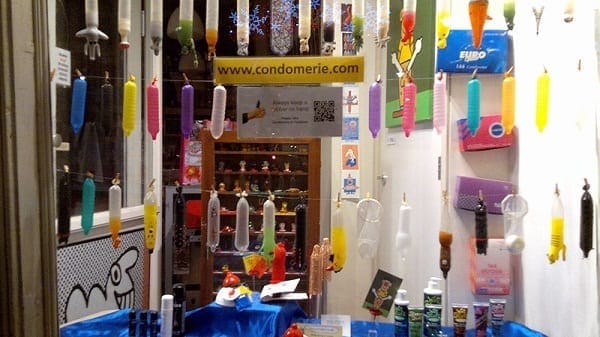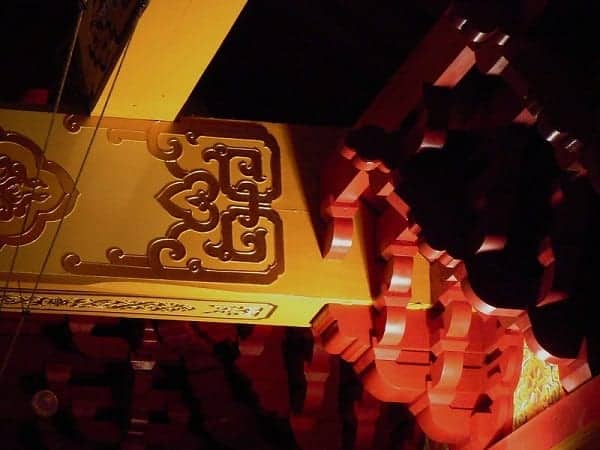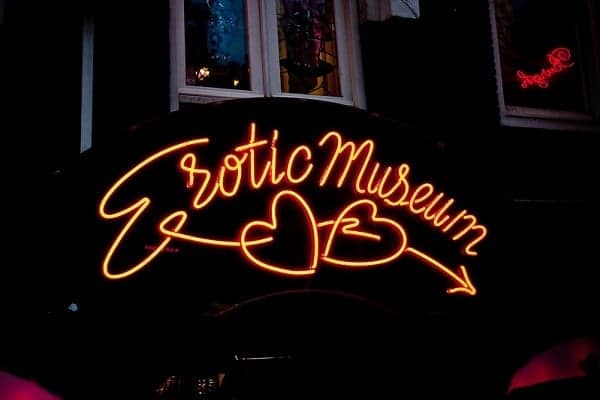This free, self-guided walking tour will introduce you to the historic sites and the modern attractions of De Wallen, Amsterdam’s oldest neighborhood.
- Audio Tour
- Additional Recommendations
- Each Stop on the Tour
- Other Stops in the Area
- Questions Answered
It's here that you'll find the famous Red Light District. But there's so much more to the area than just that, and you'll find many of these sites on our audio walking tour.
We offer an audio tour of the Red Light District, one researched, written, and recorded by one of our tour guides.
The route is a little less than 2 kilometers or just over a mile. If you just walk and listen, you’d be done within an hour. But of course, feel free to stop and spend time along the way. The tour can be done as your own pace.
The tour begins in Dam Square, near the Royal Palace where lots of public transit options visit. It’s less than a ten-minute walk from Amsterdam Central Station, and the Rokin stop on the North-South Line of the metro is even closer.
- Purchase an audio tour – $2.99
- Get a confirmation email with .mp3, .pdf, and embeddable Google Map
- Enjoy the tour(s).
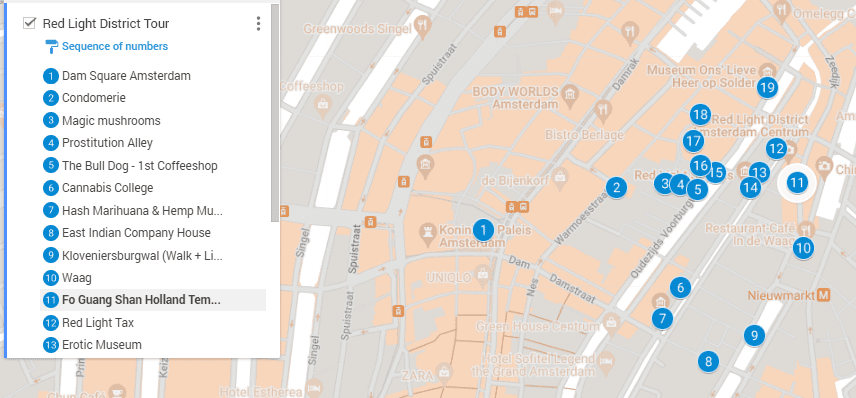
ADDITIONAL TOUR-RELATED RECOMMENDATIONS
We can also recommend pay-what-you-will guided tours of Amsterdam.
A few of the museums and historic sites we pass along the way are included in tourist discount passes.
The most common all-inclusive pass, I Amsterdam, includes the Nieuwe Kerk, the café In De Waag, the Red Light Secrets Museum, the Oude Kerk, and Our Lord in the Attic Church, as well as many other attractions in other parts of the city.
Some of these passes offer free or reduced public transit, too. We have a blog post breaking down each Amsterdam Tourist Pass option to help you pick the best one for your plans.
And we can also help you with more ideas for things to do in Amsterdam, including boat and bike tours, live music, free activities, food, music, and museums:
Below each stop on our audio tour is listed, along with information you might find of interest.
We hope you enjoy a visit to one of the oldest parts of the city and the many interesting sites along the way.
1. National Monument and Dam Square
You’re in the oldest and one of the most active parts of Amsterdam, and it’s in this central location that the people of the city chose to honor their war dead.
The National Monument is a cenotaph – an empty tomb – representing Dutch people killed during multiple wars, beginning with World War II, and it’s a gathering point on the annual Remembrance Day on May 4th.
The space that surrounds the monument is Dam Square. It’s named for a dam in the Amstel River that was built at the site around 1270, giving the city its name.
The Amstel used to run through this square, but that part of the river was filled in, and the water today disperses between the neighborhood’s canals. Because of the river, trade in the area first gathered around this spot.
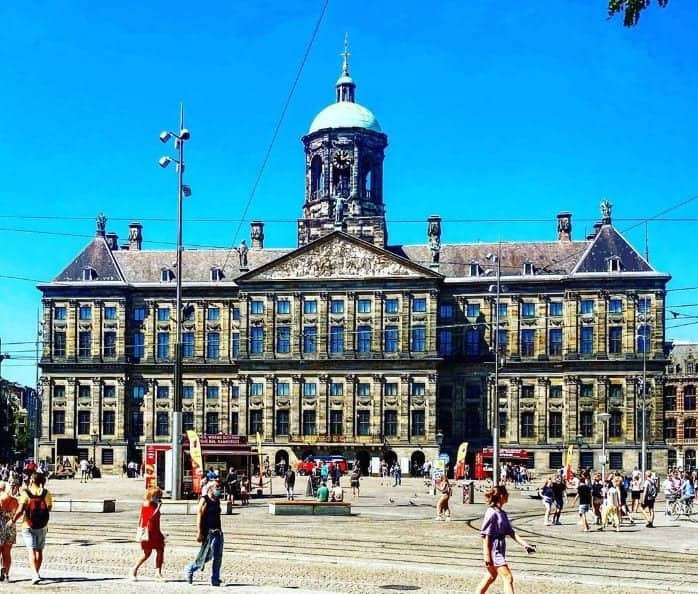
The largest building in the square, on its west side, is the Royal Palace, built as a city hall in 1655.
At that time, Amsterdam was the center of business, technology, and art in Europe.
This period, the Dutch Golden Age brought about many of the Netherlands’ most famous contributions to science and art.
Amsterdam in that era also became the home of the world’s first stock exchange and the largest company in the world.
You can explore most of the palace on weekends.
It’s open Friday from 12-5 pm, Saturday and Sunday from 11 am - 5 pm. Tickets are 10 Euros, 9 for students, and free for those under 18. Audio guides are available for free.
To the right of the palace is the Nieuwe Kerk, or the New Church.
It’s Nieuwe because it was completed in 1408, compared with the Old Church or Oude Kerk, built in the early 1200s, which we’ll see later.
Today it’s mainly an art and concert space. Current events are listed on the Nieuwe Kerk website.
2. Condomerie
This street, Warmoesstraat, is De Wallen in a nutshell – a mix of historic buildings, tourist amenities, gay and leather bars, sex shops, and art space (W139, right next door).
And nothing says Red Light District like a boutique condom shop.
You’ll see a frankness and positivity about sex here – think cute smiling condom mascots – that’s par for the course in the neighborhood.
The shop opened in 1987 with a mission in mind. The AIDS crisis was underway, and access to and good information about condoms could save lives.
Employees here are trained and ready to have an unabashed conversation about customers’ specific needs in terms of fit, allergy, personal taste, and more – something you can’t expect from a typical pharmacy clerk.
3. Magic Mushrooms
This is one of De Wallen’s many smart shops, which carry smoking paraphernalia, health food items, and resources for growing cannabis (which residents of Holland can legally do, up to five plants per person).
The name of this particular shop is a little misleading.
Places like this can sell some naturally occurring mind-altering substances, like peyote, mescaline, salvia, ayahuasca, and magic fungi – but not magic mushrooms.
As of 2008, they’re categorized as hard drugs, alongside things like cocaine and LSD.
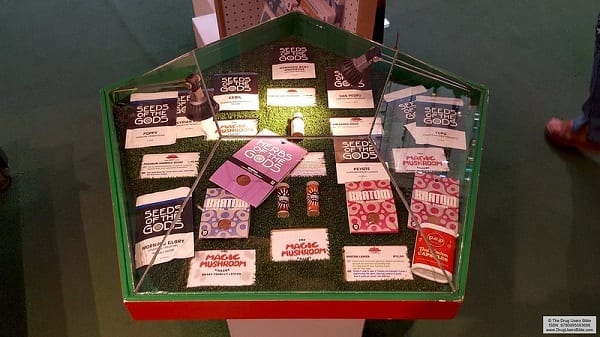
But the specific wording of the law left out what is commonly called truffles – underground fungi with the same active ingredient and similar effects to their mushroom counterparts.
The philosophy of Dutch drug law is a harm reduction approach, categorizing certain substances as “soft drugs” and regulating them much like what you’d see for alcohol in many countries.
The idea is that this separates the markets for soft drugs and hard drugs, making it less likely that people will find their way from the less dangerous to the more dangerous stuff.
4. Dollebegihnensteeg
This alley is one of the areas where window prostitution is practiced.
Again, if you’re here during work hours, please bear in mind that taking pictures of the people working in the windows will get you dirty looks at the very least.
Window prostitution is one form of sex work that can legally take in Holland.
A sex worker who operates out of one of the windows rents the window for a shift, for something in the area of 100 to 150 Euros.
In the course of a day, she may make much more than that or barely break even, depending on the season.
If a prospective client approaches the door, she can open it to discuss prices and services. A closed shade means the room is in use.
A red light over the window indicates a cisgender woman; blue lights indicate transgender women.
Male sex workers tend to operate online, outside the legal framework, and as of 2024, there’s one all-male brothel in the city.
Legal or at least unpunished sex work has a much longer history in De Wallen than legal drugs do. In some periods it’s been regulated, while in others it’s been officially banned but tolerated in certain forms.
As of 2000, the law recognizes sex workers as a legitimate part of the workforce.
The current system, as with drugs, is mainly about harm reduction.
Legalization and regulation, the notion goes, help to separate consensual sex work by people who have chosen it as a career from the kind of international human trafficking that exists outside the law in cities around the world.
The same law that legalized sex work in 2000 also increased penalties for coercing someone into it.
5. The Bullgog
This is a coffee shop in the Dutch sense of the term, meaning a place that sells small amounts of cannabis. That’s separate from a coffee house or a café, where you can actually buy coffee.
This one is the oldest coffee shop in the country, and its founder, Henk de Vries, is responsible for the potentially confusing choice of names. He chose the name “coffee shop” for the ambiance it suggested – a cosmopolitan place to meet, hang out, and talk.
He started by selling matchboxes of cannabis at a music festival in the 1970s before it was decriminalized. He noticed that with enough popular support and the Dutch culture of soft enforcement, police could be persuaded to leave him alone.
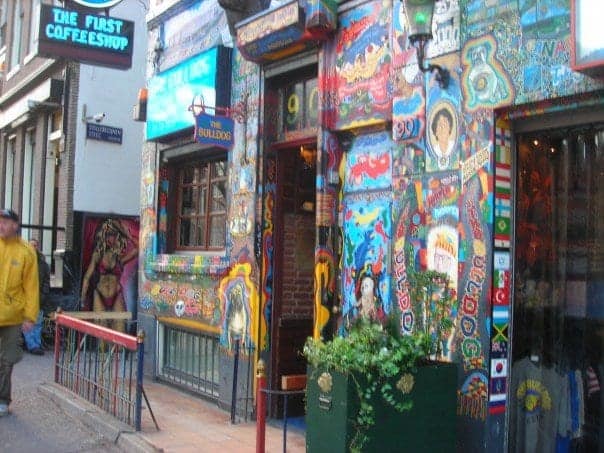
A few years later, he opened this business and relied on the same gentleness to keep his doors open. While the business was running, Dutch law changed to list cannabis as a soft drug, to decriminalize possession of small amounts, and to allow establishments like his to sell it under highly regulated conditions.
As of 2024, “small amounts” means under five grams, so that’s the maximum purchase and the most it’s legal to carry. It’s meant to be consumed on the property and they aren’t allowed to sell alcohol or tobacco or other drugs.
And customers must be 18 or older. It’s also illegal to advertise cannabis – so if you visit one of these establishments, you have to ask for the menu.
As you walk toward the next destination, you’ll pass by a few of the Bulldog’s sister locations offering drinks, food, and souvenirs.
6. Cannabis College
At Cannabis College, you can find the same easygoing, informative attitude we saw earlier at the Condomerie. It’s a nonprofit information center, free to enter, and operating since 1997.
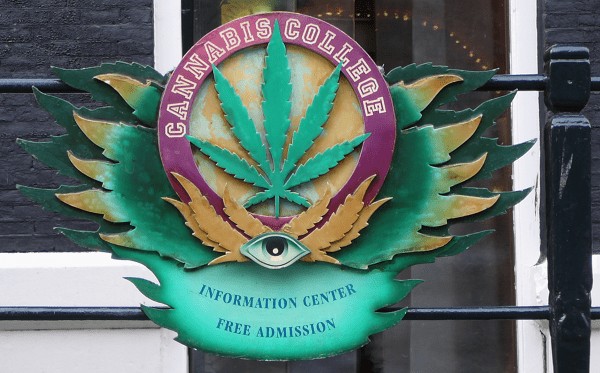
They have a small public library of cannabis-related material; you can take a quiz and receive a cannabis diploma; they offer workshops to train coffee shop staff and non-professional enthusiasts; and they maintain an indoor garden, where growers can talk about nutrients, pest prevention, and anything a different kind of gardener might think about for roses or petunias.
Current law allows possession of five plants, so the garden here consists of five very large plants. Their website lists any events or talks they may be holding.
The college is open from 11 am-7 pm daily.
7. Hash Marihuana and Hemp Museum
The Hash Marihuana and Hemp Museum consists of two buildings, located a short walk apart from each other, each with the museum’s name on the front.
The one further from Cannabis College is the main part of the museum and its home since 1987. That part covers the history of cannabis as seen through art, culture, science, business, religion, law, and medicine.
You’ll see exhibits about popular misconceptions, smoking devices from many times and places, and again, live plants.
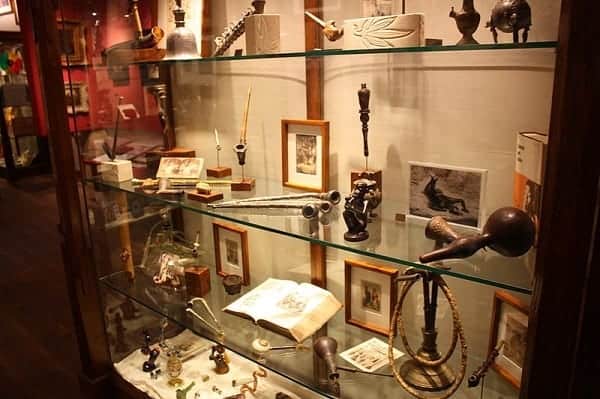
The other building, just a few doors down from Cannabis College, is the Hemp Gallery. Certain types of the plant produce some of the toughest natural fibers in the world, used in clothing, modern plastics, and the rigging of ships.
Ships powered the Dutch Golden Age, and hemp kept ships moving, so it’s safe to say that without the cannabis plant, Amsterdam wouldn’t be nearly the city it is today.
Tickets are 9 Euros. Audio guides are available for free and are an essential aid to understanding the museum. It’s open 10 am-8 pm daily. Learn more about the Hash Marihuana and Hemp Museum.
8. Voc/Dutch East India Company
This is the former corporate headquarters of the Dutch East India Company. It’s a large building, especially for Amsterdam, and between 1602 and 1799, the company inside became larger than any that had ever existed before it.
In Dutch, the company is referred to as the VOC, the initials of its full Dutch name. You’d see those letters on nearly anything the company created. The company had its own corporate logo (one of the first in the world), along with its own flag and its own military.
It was also the first company to officially issue shares to the public. In many ways, it was a predecessor to the huge multinational corporations of today.
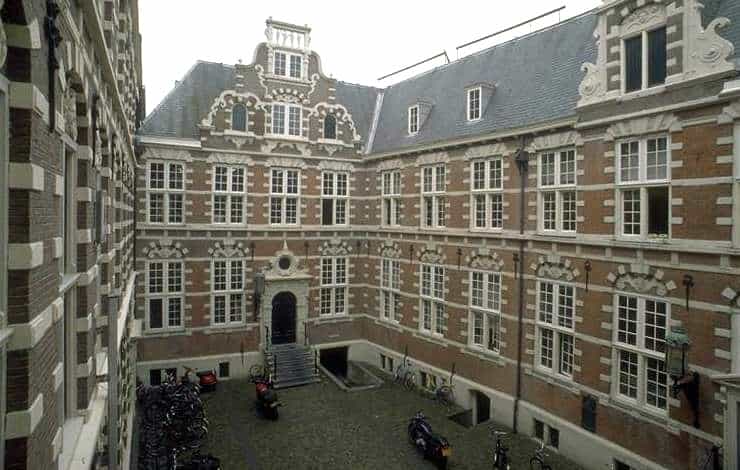
The company financed expeditions to various parts of Asia for trade goods, especially spices, but also silk, coffee, and porcelain. It also financed wars to seize land and build plantations, and built cities, installed governments, and tried and executed people who undermined its interests in the lands it controlled.
This made the Netherlands one of Europe’s major colonial powers. Dutch holdings at the peak of the Dutch Empire included parts of modern Canada and the United States, South America, the Caribbean, southern Africa, and south and southeast Asia.
You can find Dutch place names in New Zealand and Australia. And the Dutch were the only Europeans who could trade with or even visit Japan for over 200 years.
9. Kloveniersburgwal
A couple of notable buildings stand on either side of this canal. On one side, at number 29, is the Trippenhuis, the largest residence in Amsterdam, today the home of the Royal Netherlands Academy of Arts and Sciences.
From the street, you can see its long, Classical stone façade with decorative cannons at the top and chimneys shaped like huge, ornamented mortars. The Trip brothers, who originally shared the house, were arms dealers.
Local popular legend has it that after this house was built in 1662, someone wished aloud that they could have a house as wide as just the front door of the Trippenhuis. And on the other side of the canal at number 26, you can see that very house, a white building slightly shorter than its neighbors and only two and a half meters wide.

The canal here is called the Kloveniersburgwal, a name meaning “city wall of the Kloveniers,” who were municipal guards. Many of Amsterdam’s canals used to be moats that bordered city walls, which gave the red-light district the name De Wallen or “the walls.”
As medieval Amsterdam slowly grew, new walls were built and new canals dug, while the old walls were torn down and the old canals came to be used for transport.
In the Dutch Golden Age in the 17th century, the city saw massive growth, and most of the modern canals were built within a single century. Today about a quarter of the city’s surface is water.
Besides defense and transport, the canals have served other purposes: they help prevent floods, they’re home to more than two thousand houseboats, and they provide a place for canal boat tours. We have some recommendations here.
10. Waag
The Dutch word “waag” is related to the English word “weigh,” and this building was a weighing house. It’s the oldest secular building in Amsterdam, begun in 1488.
Originally, it was one of the gates allowing passage through the city walls. In the 17th century, when the walls along the Kloveniersburgwal canal were torn down, the gate house was left behind to become the place where goods brought into the city were weighed for taxing. The filled-in portion of the canal around it became this square, called Niewmarkt.
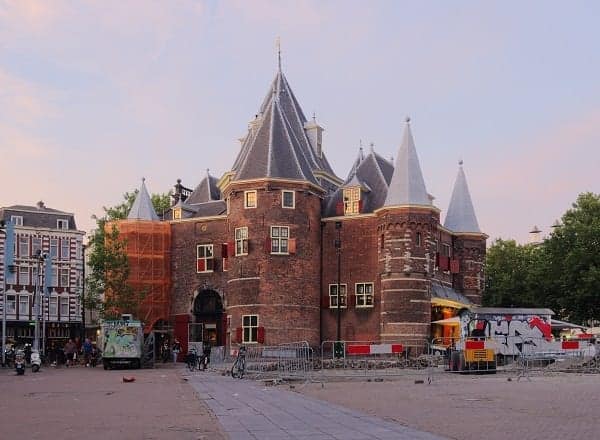
Today Nieuwmarkt is mainly restaurants, coffee shops, and cafes, but on the weekend, the old street market atmosphere still comes back to life. Throughout the year there’s a Saturday food market from 9 am to 5 pm, and if you’re here between the same hours on Sunday between May and October, you’ll find an antiques and crafts market.
The Waag also became the home of several trade guilds in the 17th century. You can find signs over three of the entrances indicating which trade occupied the portion that the door led to.
The building has been restored to its 17th-century design, and you can experience it with the help of In De Waag, the restaurant and café located inside. For the price of an upscale meal or just a coffee or a drink, you can get some historic atmosphere, including lighting mostly by candles in the evening.
11. Fo Guang Shan He Hua Temple
This is a Buddhist temple, the largest traditionally built one in Europe, and a hub of Amsterdam’s Chinatown.
While the Netherlands has a long history of trade in Asia, it was only in the early 20th century that Chinese people began to live here, most of them arriving in connection with the shipping industry.
These new arrivals settled into a neighborhood that at the time mainly served sailors – you can still see some old seedy sailor bars further along this street.
The temple includes classic design elements, like the three-arched gate – a central arch for clergy and two outer arches for lay people – plus the Chinese zodiac figurines along the gate’s roof and a statue of the bodhisattva Guanyin inside.
On the less traditional side, if you look to the left and right of the main building, you’ll see twin structures, built as part of the temple complex, that combine traditional Chinese decoration with the basic shape of a Dutch townhouse.
Visitors are welcome during open hours. Those are Tuesday through Saturday, 12-5 pm, and Sunday, 10 am-5 pm. Half-hour guided tours are offered, with no reservation necessary, on Saturdays at 2, 3, and 4 pm. Events, including celebrations of Chinese holidays, are on their website.
12. Red Light Tax
Red Light Tax is what it sounds like – a tax office for sex workers.
Even in a place like Amsterdam where sex work is legal, life in the industry is financially complicated. Each sex worker is their own small business, they have complex regulations to follow, and moral attitudes can make it hard for them to get bank accounts and other financial services.
On top of that, most sex workers are not native Dutch, so they carry on business in a language that isn’t their first. The translation is one of the popular services Red Light Tax offers.
There are plenty of other interesting things to see in the area. Below are a few you might find of interest.
Don't forget to check and see which ones might be included in one of the discount tourist passes.
13. Erotic Museum
Take a moment to appreciate the garish neon sign that says “Erotic Museum” on this building. Then look further up and a little right of center and you’ll see a small plaque with a caption reading “God is mijn Burgh” – God is my castle. This combination of historic piety and present notoriety is classic De Wallen.
As for the museum behind those signs, it doesn’t always live up to visitors’ expectations of “erotic,” or “museum” for that matter.
It’s a collection of curiosities – ancient erotic art, vintage sex toys from various parts of the world, modern art in the vein of a topless Mona Lisa, a collection of drawings by John Lennon, and a room decorated like Alice in Wonderland where you can watch a sexualized Snow White cartoon.
It’s open Sunday to Thursday 11 am to 1 pm, and Friday and Saturday 11 am to 2 pm. Admission is 7 Euros.
14. Red Light Secrets - Museum of Prostitution
Red Light Secrets is a museum about sex work. The building is a former brothel, including the bedrooms, S&M spaces, the office, the red-lit windows, and the lost and found, where you can see items that customers left behind – like dentures.
Visitors to the museum are guided by twelve audio stories, first-person accounts from sex workers about their time on the job.
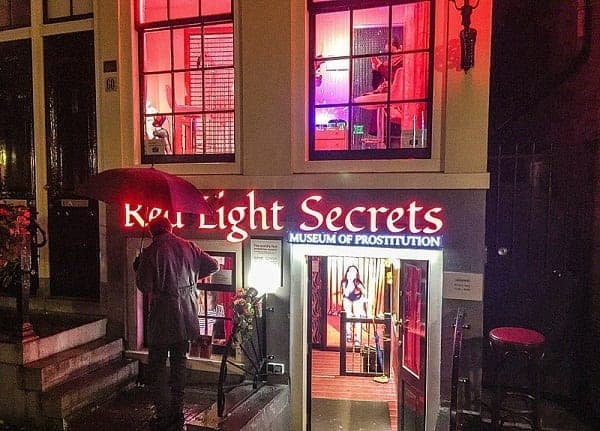
This is the only place in the neighborhood that welcomes photos of the red-light windows, and visitors are offered the chance to pose in them.
Another popular feature is a confessional where visitors can write down fantasies or embarrassing secrets – with the possibility that they’ll be posted on the museum’s Instagram page (anonymously, of course).
Tickets are 12.50 Euros. It’s open Sunday through Thursday, 11 am-6 pm, and Friday and Saturday 12-8:15 pm. The last admission is fifteen minutes before closing. The minimum age of admission is 16. Purchase tickets or learn more.
15. Toilet
This small metal structure near the canal is one of Amsterdam’s public toilets. They were installed in the mid-19th century to accommodate a small number of male public workers, and the system hasn’t been updated much to reflect the very large number of visitors of multiple sexes exploring the streets today.
This kind is known as a pee curl. The kindest thing that can be said about them is that they save lives. Men out on the town can be tempted to do to what Amsterdammers call “wild peeing” – that is, using the canals for one of their oldest purposes.
Besides being illegal, wild peeing is dangerous. A few people drown in the canals every year, and inevitably, a portion of that number is men with their pants unzipped. A pee curl may not be inviting, but it’s better than death.
For women, though, neither the canals nor the pee curls have much to offer. A small number of modern public toilets, a few pee curls with some special hardware to accommodate women standing up, and the toilets in businesses – which you generally have to pay to access – is the extent of what’s available.
For some added entertainment, the online reviews of this particular pee curl are worth a read.
16. Bronze Breastplate Sculpture
This one is easy to miss – it’s a small bronze sculpture, flat on the ground, among the cobblestones near the wall of the church, of a hand on a breast. Even here, in the halo around Amsterdam’s oldest church, the Red Light District is still the Red Light District.
This may seem like the stuff of pranks, but the fact that it’s been here undisturbed since 1993 is a hint that the city knows and permits its presence. In fact, it’s part of a series of bronze sculptures by an anonymous artist, mostly located in Amsterdam.
Another one is a large sculpture of a violinist coming up through the floor of the local opera house – something that would have been hard to place without permission and collaboration.
The official line is that the artist is a medical professional who prefers anonymity, but plenty of theories are out there as to the identity of the real creator, including former Queen Beatrix, who is a sculptor.
17. The Old Church
The Oude Kerk or Old Church is the oldest building in Amsterdam, begun in the early 13th century. Since that time, it’s been given many renovations and expansions in various styles.
It’s much simpler inside than outside. Apart from some beautiful stained glass, the graves that mark the 10,000 burials in the church floor, and some impressive musical artifacts – 39 bells and four organs – you wouldn’t see the richness that’s typical in churches of this age.
That’s because of the Dutch Reformation, which turned this from a Catholic church to a Dutch Reformed church in 1578. Reformers raided churches and destroyed objects they considered unholy, including saint icons and elaborate altars – anything that might distract from the language of the sermon.
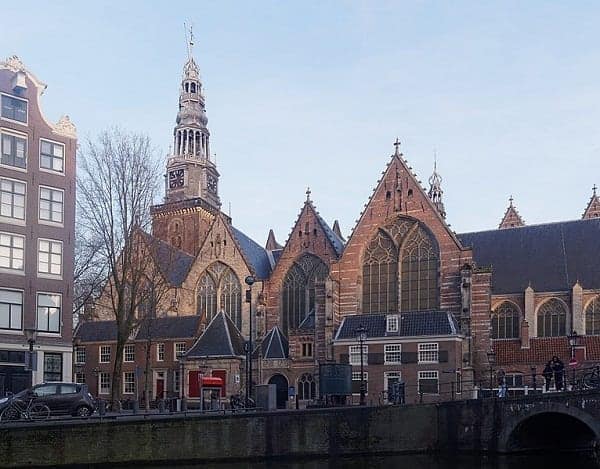
In some places, pipe organs were among the things destroyed. But this church became famous for organ music and for the career of a particular organist and composer, Jan Pieterszoon Sweelinck.
Organs in Dutch churches were often paid for by cities, sometimes with taxes that were still strong in the memory of the very citizens stripping the icons from the church.
And after the Reformation, cities went on to maintain organs and organists at their own expense, even when clergy weren’t always fond of the fact.
Today, the church is an art space, used for installations and music events. It’s open Monday through Saturday, 10 am-6 pm. On Sundays, the church holds services in the morning and is open to the public from 1-5:30 pm.
Tickets are 12 Euros for adults with discounts available. Access to an audio tour is included with the cost of entrance. Their website can tell you what’s on right now.
18. Prostitution Information Center
This is one of many buildings around the church and not the most obvious one – you’ll know it by the letters PIC in the window.
The Prostitution Information Center is a bit like the Red Light Secrets Museum we saw earlier – a place that offers a calm, humanizing, insider perspective on the real lives of sex workers. Staff at the center are usually current or former sex workers themselves.
It’s founded in 1994 by former sex worker Mariska Majoor. She’s also responsible for the installation of Belle, the statue you may have seen on the side of the church, not far from the bronze cobblestone, of a woman standing in a doorway, with a caption reading, “Respect sex workers all over the world.”
Inside, the PIC has a café atmosphere – there are drinks on offer and sometimes pie – with some space to sit down and peruse their reading material.
There’s also a model room, to offer a sense of the spaces that Amsterdam’s sex workers spend their day in. And there’s a shop with books and other educational materials for sale, along with t-shirts, condoms, magnets, and miniatures of Belle.
They’re open Wednesday through Saturday, 2:30-5:30 pm. At 5:30 on those same days, they offer a tour of the neighborhood focused on the subject of sex work. It’s 25 Euros per person, with no reservation required. Special presentations are also held here intermittently; you’ll find those and more information on their website.
19. Ons' Lieve Heer Op Solder (Our Lord in the Attic Museum)
Our Lord in the Attic is a museum, a home, and a church all in one building located on Oudezijds Voorburgwal.
The museum office is the modern building on the right; the home and church are in the building on the left. The home was built in 1630, and the church was added in 1663, the year Catholic services were banned.
Even after the ban, Catholics didn’t all convert or disappear, and it’s still a major religion in the Netherlands today. Rather than comply, Catholics went underground, or rather overground – in this case, into an attic.
The word “attic” might give you humble expectations for what waits upstairs. But the church occupies not just the attic, but also the top two floors. It’s large enough to fit an organ, a living space for the priest, and 150 people.
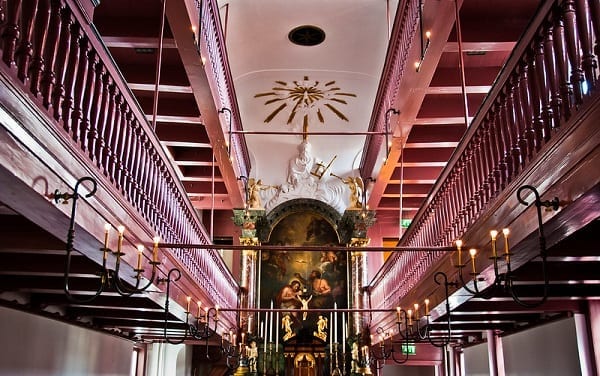
While the entrance was behind a secret door, it would have been impossible to hide this many people coming and going from the house every Sunday, not to mention the conspicuously missing top two floors. As with soft drugs and sex work in their own eras, Catholicism became a thing that was officially banned by the state, but in a way that went unenforced as long as it was kept inconspicuous.
The house is still furnished as it would have been in the 17th century when it was the home of a rich merchant. The exhibits introduce a visitor to the daily life of the era as well as the history of religious freedom in the Netherlands.
It’s open Monday through Saturday from 10 am to 6 pm and Sunday from 1 to 6 pm. The museum also includes a shop and café. Admission is 8 Euros for adults or 4 Euros for 18 and under.
QUESTIONS ANSWERED ABOUT THE RED LIGHT DISTRICT
Tourists often have questions about the Red Light District and we've answered some of the most popular ones below.
What is the Most Famous Street in the Red Light District?
Something few tourists know is that there are 3 red light districts in Amsterdam.
The most famous one, and the one most tourists call the Red Light District, is known as De Wallen. This is where hundreds of windowed brothels line the streets. You'll find this on Oudezijds Voorburgwal, Oudezijds Achterburgwal, and some connect alleys.
The second largest, which has about 65 windows, is Singelgebied, near the corner of Spuistraat and the Singel Canal. This is in a quiet tree-lined neighborhood and is much less lively than De Wallen.
The smallest is Ruysdaelkade. This one, which has about 40 windows, tends to be frequented by locals. You won't find many tourists there.
Are There Rules in the Red Light District?
It’s easy to think that anything goes in the Red Light District (De Wallen). But there are some rules worth knowing.
As with many tourist neighborhoods, watch out for pickpockets. They are likely the biggest threat to tourists.
Marijuana and alcohol are both easy to find here, but it isn’t legal to consume them outside or to walk around under the heavy influence of either one.
In fact, in March of 2023, new rules were introduced meant to crack down on the "nuisance behavior" caused by drunken tourists. There is currently a curfew that closes the doors of sex businesses at 3 am rather than 6 am, something sex workers are currently protesting.
There is also a proposal that would restrict alcohol sales and smoking on the street.
Sex work is legal, but taking pictures of sex workers standing in brothel windows is strongly frowned upon. You don't want to take out your camera and get in trouble.
It's also considered rude to tap on the widows, to stand and stare at the workers, or to shout out insults.
And while there’s a lot to look at, do check the ground once in a while to make sure you aren’t walking in a bike lane.
Especially at night, there will be loads of bouncers calling out to you to come inside and enjoy the 18+ entertainment and attractions (things such as peep shows, live sex shows, and strip shows). Some shows are rather dodgy though, so feel free to ignore the calls and keep walking.
You may also find street dealers offering to sell you drugs. The city has launched a campaign against dealers, and many arrests have been made in recent years. There's too much chance of getting bad drugs, robbery, and getting scammed by dealers to risk getting involved in a transaction
Do You Need Cash in the Red Light District?
For those visiting sex workers, yes, cash is needed. They do not tend to accept credit cards.
Other than that though, there's no cost to walk through the streets of the Red Light District.
What is the Best Time to Visit the Red Light District
The answer to this question has many answers.
A walking tour past many of the sites listed in our audio tour can take place any time of day. Note that the later it gets, the more likely you'll run into rowdy groups of bachelor parties and people who have been imbibing. However, an afternoon or early evening tour works just fine.
For those wanting to partake in other activities in the area, many sex workers start their job at midnight. There's a current regulation that closes them at 3 am, but historically they have been open until 6 am.
Sex shops tend to open around 10 am and noon and close between 8 pm and 9 pm.
Sex shows have varying hours. The Moulin Rouge is either open between 2 pm and 2 am, or 8 pm and 2 am. Cassa Rosso opens around 7 pm and closes between 2 am and 3 am. You'll want to check online for the most recent schedules.
Is the Red Light District Safe
Yes. Many people live and work there so there are always loads of people around. There are often many police officers as well.
As mentioned above, pickpockets are likely the biggest threat to tourists.
Can Anyone Go to the Red Light District
Yes. These are normal streets, along canals, surrounded by homes and businesses.
The streets are full of tourists. Some are interested in the tourist attractions in the neighborhood. Others in hoping to see the famous red windows. Others are there to hire sex workers and go to shows.
Can You Avoid the Red Light District
Absolutely. However, if seeing sex workers is what bothers you, you might find it better to walk through the area during the day. As mentioned above, there are many sites worth visiting that have nothing to do with the sex industry.




